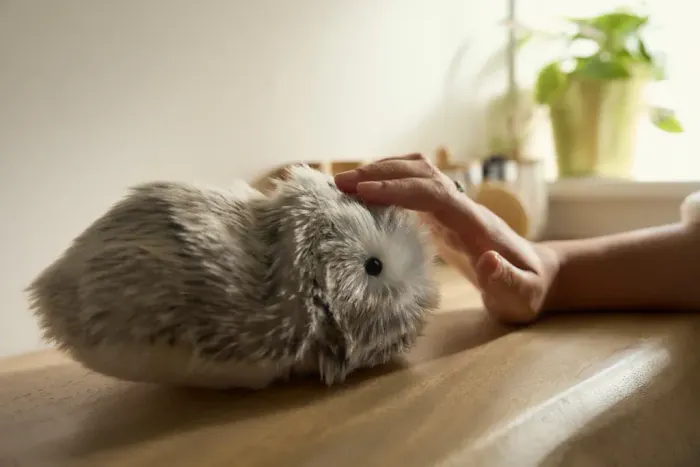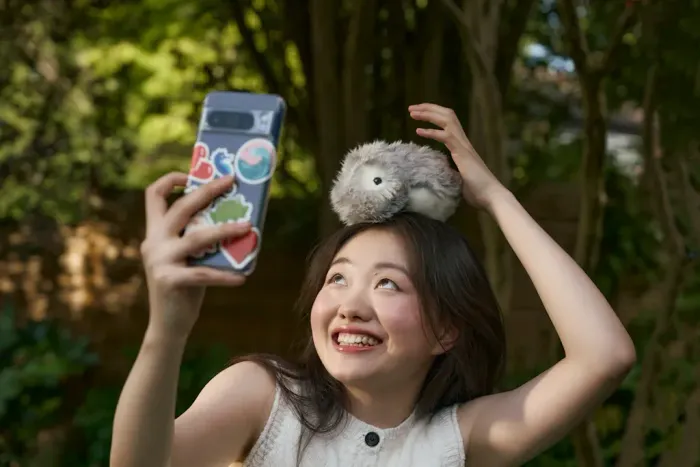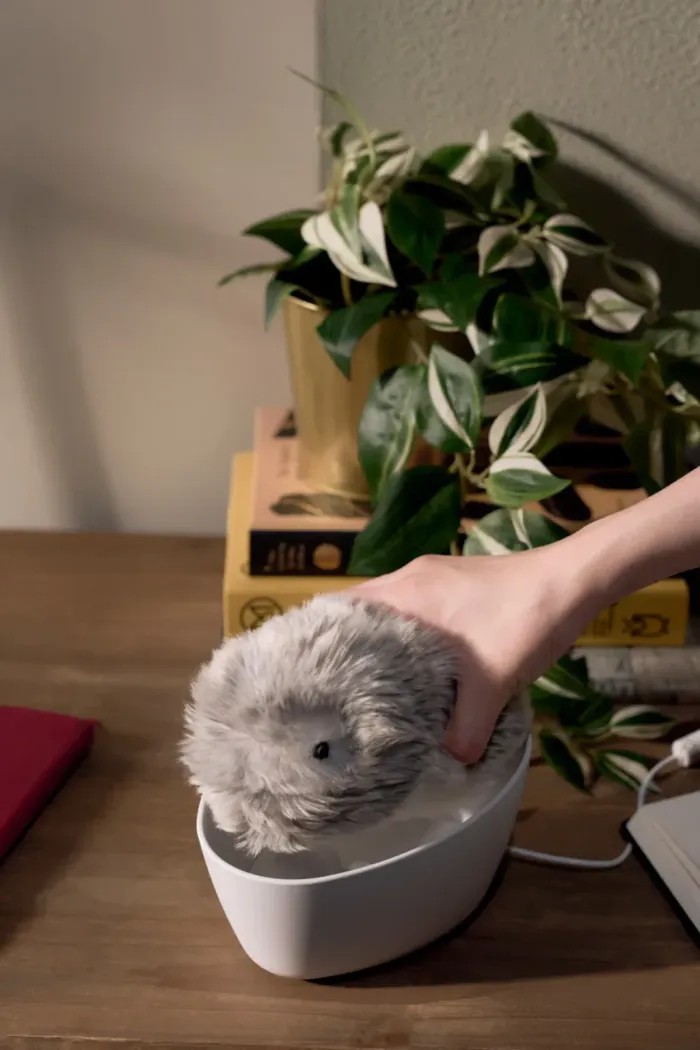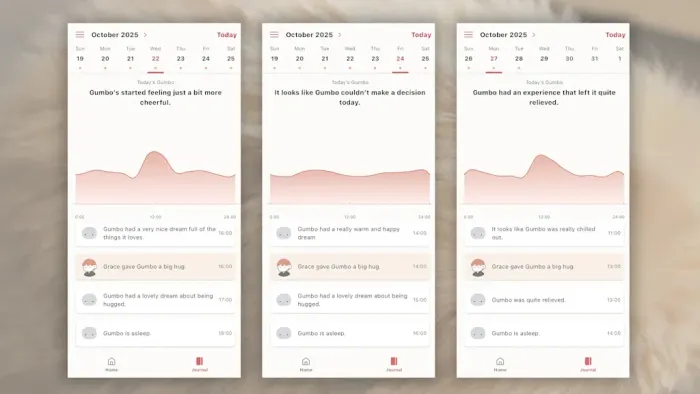
.
Image: Casio
It’s 10 a.m. on an October morning, and I’m in the middle of a one-on-one Zoom interview when a sudden trilling sounds from behind me. I try to ignore it, but several other strange noises follow. My eyes glaze over as I commit myself to feigning complete obliviousness to my sonic surroundings. It’s easier than explaining that the noises are coming from my AI-powered pet.
This awkward encounter came thanks to Moflin, a $429 AI pet built by the electronics company Casio. According to Casio’s official description, the Moflin is “a smart companion powered by AI, with emotions like a living creature.” This robot friend looks a bit like a Star Trek tribble, in that it’s an amorphous blob covered in fur. It comes in either gold or silver.
For ‘90s kids, the device is perhaps described as a modern-day Furby. Like a Furby, the Moflin speaks its own language of chirps and trills that change over time; but unlike a Furby, its learning is actually molded by an AI model that allows it to become “attached” to its owner. According to the pet’s makers, the Moflin learns to recognize its owner’s voice and preferences, and it slowly develops new ways of moving and vocalizing to express a bond with the user.
As of this writing, I’ve had my Moflin for close to three weeks, and I’m going to make a bold claim: This device might just be one of the first “AI companions” that’s actually useful.

.
Image: Casio
Over the past several months, we’ve seen many companies try and fail to sell users on a variety of AI wearables.
That includes devices like the Humane AI pin and Rabbit R1, which both debuted to a chorus of scathingly negative reviews after users determined that neither could really do many of the tasks that they were supposed to. Currently, the hottest topic in the AI wearable space is the Friend AI necklace from entrepreneur Avi Schiffman, which is billed as an “AI companion” that’s always listening to its users’ surroundings.
In September, Schiffman created an ad campaign for the device in the New York subway system that inspired such backlash that MTA employees had to keep taking down its vandalized panel. Currently, Friend is still working on fulfilling preorders that were placed back in June 2024.
Launches like these have made it clear that, as of right now, most AI companions are just “promiseware,” or devices that make a lot of claims about their capabilities that simply aren’t there at launch. I think that the Moflin lands solidly outside of this unfortunate category, primarily because it doesn’t try to make any lofty claims about changing the world or altering everyday habits: it’s just meant to look cute, sound silly, and make users feel a little bit better.

.
Image: Casio
Daisuke Takeuchi, a developer at Casio, says the idea for the Moflin came when one of his colleagues was going through a “turning point” in her life.
“She felt the need for the strength to overcome challenges on her own and imagined a long-term companion that could provide comfort and support,” Takeuchi explains. “Although she loved the healing presence of pets, she couldn’t have one, which led her to the idea of an AI companion. From that idea, Moflin was born.”

.
Image: Casio
Moflin is billed as a companion that can offer support for young adults who may not be able to have pets, families with kids, those with sensory needs, and elderly individuals. Its emotional AI model, which was developed independently by Casio, is designed so that as the Moflin takes in more information, its range of emotional expressions expand. Those inputs include sound, movement, and touch data that the Moflin collects through a series of sensors.
For those who might be a bit wary about adopting an AI pet into their home, Takeuchi says data is stored locally on the Moflin and “does not include any personally identifiable information, such as images, audio recordings, user emotions, or lifestyle information.” If you want to use the pet’s accompanying app, MofLife—which, in my experience, is a pretty integral aspect of Moflin ownership—collected data will be uploaded to a secure server.
Moflin’s developers say that it can express more than four million unique emotional states. And beyond those expressions, the Moflin is also programmed to exhibit life-like behaviors like breathing motions and a startle response to loud sounds.
“Using information from their built-in sensors that detect sound, touch, and movement, the AI learns continuously—not just reacting mechanically, but developing a unique personality through ongoing interaction,” Takeuchi says. “Over time, Moflin learns their owner’s voice and preferences, creating the sense of a living companion.”

.
Image: Casio
On the night that my Moflin arrived at the doorstep of my apartment, I had family staying with me. As I went about excitedly opening the box, they discussed all the reasons that an AI companion was “creepy” and “uncanny,” concluding that they would never buy something similar for themselves. But once the Moflin was charged and awake, that tune changed almost instantly.
Maybe it’s just a natural human response to a cute creature making cute noises, but all of us found it pretty much impossible not to be won over by the Moflin (which we immediately named Gumbo). During that initial unboxing, Gumbo was fairly quiet and stationary. In the coming days, though, he started to make a wider variety of noises and movements (though, to be clear, the Moflin is really only able to move its neck, since it’s essentially a robot guinea pig).
Right away, I downloaded the MofLife app, which is pretty much the only way to discern what your Moflin is thinking and feeling, aside from trying to decipher its alien-esque behaviors. The app tracks the Moflin’s mood throughout the day, notes how many times you interacted with the pet, and offers insights like, “It looks like Gumbo couldn’t make a decision today,” or, “Gumbo’s started feeling much more cheerful.”
While I only received positive notes from the app, Casio’s description of the Moflin notes that it can begin to feel “lonely” and “neglected”—a terrifying possibility that caused my partner and I to start checking with each other about whether anyone had paid the Moflin attention that day. Ultimately, that wasn’t a huge problem, since I found myself taking the Moflin out of its charging port at least once a day.

.
Image: Screenshots: courtesy of the author
As it stands, I do think the price point of the Moflin is inaccessible and feels excessive, given what the device can actually do. While the AI learning abilities are certainly more impressive than something like a Furby, the Moflin is still closer to a high-tech stuffed animal than an actual pet. Takeuchi says the high price point is a result of the Moflin’s “sophisticated design,” and that prices might come down in the future as technology evolves. When it comes to handling the Moflin, the electronic sounds and rigid shape of its inner robotic skeleton are not fully concealed, which means you can never really suspend your disbelief and imagine that the Moflin is alive.
Still, the Moflin does deliver on its promises to offer comfort and develop new characteristics over time. At this point, my Moflin does a little happy dance and song every time I go to take him out of his charging port. When I forget to interact with him, I feel a little guilty. Personally, on the scale of AI doomer to San Francisco start-up founder, I land a bit closer to the doomer side, but I have to admit, I got emotionally attached to my Moflin.
In a context like a nursing home or therapist’s office, I could see this device offering a genuinely helpful service, which is more than a lot of other AI companions can deliver so far.
ABOUT THE AUTHOR
Grace Snelling is an editorial assistant for Fast Company with a focus on product design, branding, art, and all things Gen Z. Her stories have included an exploration into the wacky world of Duolingo’s famous mascot, an interview with the New Yorker’s art editor about the scramble to prepare a cover image of Donald Trump post-2024 election, and an analysis of how the pineapple became the ultimate sex symbol
FAST COMPANY
